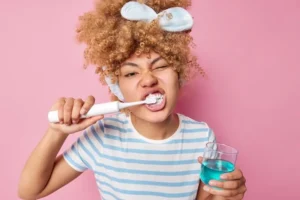Maintaining good oral hygiene is critical for orthodontic patients to ensure the effectiveness of their treatments and prevent dental issues. This article explores essential practices such as proper brushing techniques, the use of specialized tools like interdental brushes, and the importance of regular dental check-ups. Learn how to care for your braces or aligners and keep your smile healthy and bright throughout your orthodontic journey.
Brushing Techniques
Effective brushing techniques are essential for maintaining good oral hygiene and preventing dental issues such as cavities, gum disease, and bad breath. Understanding the right methods and tools can make a significant difference in your oral health. In this section, we will explore various aspects of brushing techniques that will help you maintain a healthy and bright smile.
Proper brushing techniques involve not only the right kind of toothbrush but also the right method of brushing. Implementing these techniques can drastically improve your oral health and prevent common dental problems. Let’s delve into choosing the right toothbrush, proper brushing steps, and special considerations if you have braces.
Choosing the Right Toothbrush
Selecting the right toothbrush is the first step towards effective oral hygiene. The American Dental Association (ADA) recommends using a toothbrush with soft bristles. Hard bristles can cause damage to the gums and enamel. A toothbrush with a comfortable handle that fits well in your hand will make brushing easier and more effective.
There are several types of toothbrushes available, including manual and electric options. Electric toothbrushes have been shown to remove more plaque compared to manual ones, especially oscillating-rotating brushes. However, the key is to choose a toothbrush that you are comfortable using consistently. Consider these factors when selecting a toothbrush:
- Soft bristles
- Comfortable handle
- Size of the brush head
- ADA Seal of Acceptance
It’s important to replace your toothbrush or the head of your electric toothbrush every three to four months, or sooner if the bristles are frayed. A worn-out toothbrush will not clean your teeth effectively and can harbor bacteria.
Proper Brushing Steps
Proper brushing involves more than just moving the toothbrush around your mouth. Following the correct steps ensures that all surfaces of your teeth are cleaned effectively. Here are the steps recommended by dental professionals:
- Position the toothbrush at a 45-degree angle to the gums.
- Gently move the brush back and forth in short (tooth-wide) strokes.
- Brush the outer surfaces, the inner surfaces, and the chewing surfaces of the teeth.
- To clean the inside surfaces of the front teeth, tilt the brush vertically and make several up-and-down strokes.
- Brush your tongue to remove bacteria and keep your breath fresh.
Spending at least two minutes brushing, twice a day, is critical for effective cleaning. Most people do not brush for the full two minutes; using a timer can help ensure you brush for the correct amount of time.
Brushing with Braces
Brushing with braces requires a bit more diligence to ensure that both the teeth and the brackets are kept clean. Food particles and plaque can easily get trapped around braces, which can lead to cavities and gum disease if not properly managed. Special tools, such as interdental brushes or orthodontic toothbrushes, can be very helpful. These brushes are designed to clean around brackets and wires more effectively. Additionally, using a fluoride mouthwash can help to protect your teeth from decay.
Here are some tips for brushing with braces:
- Use a floss threader to make flossing easier and more effective.
- Brush after every meal to remove food particles stuck in the brackets and wires.
- Inspect your teeth and braces in the mirror after brushing to ensure they are clean.
Maintaining good oral hygiene with braces can be challenging, but it is crucial to prevent dental issues. Regular visits to your dentist or orthodontist will help to ensure that your teeth and gums remain healthy throughout your orthodontic treatment.
Interested in more tips on maintaining oral health? Check out our other articles for more comprehensive guides and advice from dental professionals.
Flossing and Interdental Cleaning
Oral hygiene goes beyond just brushing your teeth; it also involves removing plaque and food particles from between your teeth, which a toothbrush alone may not reach. Flossing and interdental cleaning play a crucial role in maintaining oral health by targeting these hard-to-reach areas. Studies have shown that incorporating these practices can significantly reduce the risk of gum disease and tooth decay.
Effective interdental cleaning can prevent many dental problems and contribute to a healthier mouth. With a variety of tools available, such as dental floss, floss threaders, and interdental brushes, it’s easier than ever to find a method that works best for you. In this article, we will explore different types of flossing and interdental cleaning tools and how to use them effectively.
Types of Floss
Dental floss comes in a variety of types to suit different needs and preferences. The most common types are waxed and unwaxed floss. Waxed floss tends to glide more easily between tight spaces, while unwaxed floss may provide a better grip but can sometimes fray.
There are also specialized flosses designed for specific needs, such as tape floss, which is broader and flatter, making it ideal for people with larger gaps between their teeth. Super floss is another option, featuring a stiffened end for threading under appliances like braces, a spongy section for cleaning around appliances, and regular floss for removing plaque under the gumline.
Using a Floss Threader
A floss threader is a flexible, loop-shaped tool that makes it easier to thread floss between teeth and around dental appliances like braces and bridges. To use a floss threader, simply place the floss through the loop, guide the threader under the appliance or between tightly spaced teeth, and then floss as you normally would.
Using a floss threader can be particularly beneficial for individuals with orthodontic appliances or dental implants. These devices can make traditional flossing techniques difficult. Studies suggest that using a floss threader can significantly improve plaque removal and reduce the risk of gum disease in these populations.
Interdental Brushes
Interdental brushes are small, cylindrical brushes designed to clean between the teeth, especially in spaces that are too wide for standard dental floss. These brushes are available in various sizes to fit different gaps, making them a versatile option for interdental cleaning. They’re particularly effective for cleaning around orthodontic braces, bridges, and dental implants.
Using an interdental brush is straightforward. Simply insert the brush gently between your teeth and move it back and forth to remove plaque and food particles. It’s crucial to choose the correct brush size to avoid damaging your gums while ensuring effective cleaning.
Research has shown that interdental brushes can be more effective than floss for cleaning larger gaps between teeth. They are also easier to use for people with limited hand dexterity, making them a suitable alternative for older adults and individuals with arthritis.
Interested in learning more about keeping your teeth and gums healthy? Check out our other articles for comprehensive guides on oral hygiene, dental treatments, and much more!
Additional Oral Hygiene Practices
In addition to brushing and flossing, there are several other important practices that can help maintain optimal oral health. Incorporating these additional oral hygiene practices into your daily routine can significantly reduce the risk of dental problems and improve overall oral hygiene. Here, we will explore some of these practices, including the use of mouthwash, the impact of diet on oral health, and the importance of regular dental check-ups.
It is essential to remember that good oral hygiene is not limited to the mechanical act of cleaning your teeth. It involves a comprehensive approach that targets all aspects of your mouth, including your gums and tongue. By understanding and implementing these additional practices, you can ensure a healthier, brighter smile.
Using Mouthwash
Mouthwash is an excellent addition to your oral hygiene routine. It can reach areas that a toothbrush and floss may miss. Mouthwash helps in reducing bacteria and plaque buildup, which are key contributors to gum disease and cavities. There are different types of mouthwash available, including therapeutic and cosmetic options. Therapeutic mouthwashes contain active ingredients that help control or reduce conditions like bad breath, gingivitis, plaque, and tooth decay.
When choosing a mouthwash, look for products with the American Dental Association (ADA) Seal of Acceptance. This seal ensures that the mouthwash has been tested for safety and effectiveness. It is advisable to use mouthwash after brushing and flossing to maximize its benefits. Swish the mouthwash around in your mouth for the recommended duration, usually about 30 seconds, and then spit it out.
Using mouthwash can provide a refreshing feel and help maintain fresh breath throughout the day. However, it’s essential to remember that mouthwash should not replace brushing and flossing but rather serve as an adjunct to these practices.
Dietary Considerations
What you eat can significantly impact your oral health. A diet high in sugars and carbohydrates provides an ideal environment for bacteria to thrive, leading to the formation of plaque and cavities. On the other hand, a balanced diet that is rich in vitamins and minerals can help keep your teeth and gums healthy. Foods that are particularly beneficial include fruits, vegetables, lean proteins, and dairy products, which provide essential nutrients like calcium and phosphorus.
Limiting your intake of sugary snacks and beverages is crucial in preventing tooth decay. If you do consume such items, try to rinse your mouth with water afterward to reduce the sugar and acid levels. Additionally, drinking plenty of water throughout the day helps wash away food particles and bacteria, maintaining a healthier environment in your mouth. Incorporating food items that require chewing, such as apples and carrots, can also be beneficial. These foods help stimulate saliva production, which naturally cleanses the mouth and neutralizes acids produced by bacteria. Understanding the impact of your diet on your oral health can go a long way in preventing dental issues.
Regular Dental Check-Ups
Regular dental check-ups are a cornerstone of good oral hygiene. Visiting your dentist at least twice a year allows for the early detection and treatment of potential dental issues. During these visits, your dentist will perform a thorough examination of your teeth, gums, and mouth, checking for signs of cavities, gum disease, and other oral health problems. Professional cleaning during these check-ups helps remove plaque and tartar buildup that cannot be addressed by brushing and flossing alone.
Besides identifying and treating issues, your dentist can provide personalized advice on improving your oral hygiene practices and recommend products that suit your specific needs. Regular dental visits also allow for the monitoring of any ongoing treatments or dental appliances, ensuring they are functioning correctly.
Skipping dental check-ups can lead to the progression of minor issues into more severe problems that require extensive and costly treatments. Therefore, adhering to a schedule of regular dental visits is not only about maintaining oral health but also about preventing future complications.
In conclusion, adopting additional oral hygiene practices such as using mouthwash, considering dietary impacts, and scheduling regular dental check-ups can significantly enhance your oral health. These practices, combined with routine brushing and flossing, contribute to a comprehensive approach to maintaining a healthy mouth. For more tips and in-depth information on oral health, be sure to read our other articles.
FAQs on Maintaining Oral Hygiene with Braces
Good oral hygiene is crucial, especially for those undergoing orthodontic treatment. Here are some commonly asked questions to help maintain the best oral health during your orthodontic journey.
What are the best ways to clean teeth with braces?
To effectively clean your teeth with braces, use a soft-bristled toothbrush and a fluoride toothpaste. Brush carefully around wires and brackets, using circular motions. It’s vital to brush after every meal and to floss daily using a floss threader which allows you to get under the archwire. Additionally, consider using an interdental brush to remove plaque and food particles from hard-to-reach areas and finish off with an antimicrobial or fluoride mouthwash to reduce the risk of plaque buildup.
How often should I visit the dentist or orthodontist during treatment?
While undergoing orthodontic treatment, regular check-ups are essential. Typically, you should visit your orthodontist every 4-6 weeks to adjust braces and monitor progress. Besides these visits, maintaining visits to your dentist every six months for a professional cleaning and dental exam is recommended. This allows your dentist to address any issues that could interfere with your treatment, such as cavities or gum problems, and ensures a consistent cleaning of areas that might be neglected during regular home care.

My name is Salman Kapa, a 73-year-old expert in bone regeneration and dental implantology. With decades of experience in the field, I am dedicated to advancing our understanding of oral health and hygiene. Through my research and writing, I aim to contribute to the development of innovative solutions in dental care.




